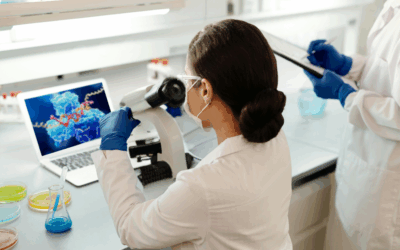In Vitro-In Vivo Extrapolation (IVIVE) is an emerging discipline that helps researchers predict the rate at which compounds metabolize within the human liver and are eliminated from the body (i.e., human clearance rate). Put simply, IVIVE uses in vitro methods to predict in vivo impact. Why does that matter? Because the main challenges new drugs face in development are long cycle times and elevated costs. Being able to extrapolate in vivo clearance rates from in vitro data helps solve both problems.
Drug developers considering the methodology will likely need a bit of background on what it is and why it’s important. So, we answered some common questions about IVIVE to help you decide if it’s the right option for your next drug.
Why is IVIVE important?
As previously mentioned, the IVIVE model uses in vitro data obtained from a relatively simple in vitro metabolic model to extrapolate rates of metabolism during the early phase of drug discovery. Scientists use it to better understand and quantify the relationship between external/internal exposure and toxicological response. The results can facilitate drug discovery, product development and chemical risk assessment. IVIVE can also reduce market development risks, shorten turnaround time and save costs during new drug development, improving the efficiency of the entire R&D process.
Why not just conduct both in vitro and in vivo studies?
In vitro research is the primary method used in drug discovery because of the high throughput it promises and the rapid results it delivers. In vitro experiments are far less costly and take less time to show results than in vivo ones, which is why they’re often preferred with new drugs. In vivo research, on the other hand, helps derive pharmacokinetic (PK) profiles of test subjects after administering a drug and can better reflect the relevant characteristics of compounds. In vivo and in vitro test methods have advantages and disadvantages, and if done correctly, IVIVE has the potential to achieve the best of both worlds.
So, how does IVIVE work?
Establishing the IVIVE method requires two important steps. First, you must obtain the in vitro experimental data of liver intrinsic clearance; then, you must establish a correction equation of liver intrinsic clearance rate in vitro. The correction equation is the ultimate goal of IVIVE research as it’s what allows researchers to accurately predict in vivo clearance rate.
The basic process is to use commercial compounds with PK data that has been measured in humans (i.e., accepted data) and use it to deduce the theoretical intrinsic liver clearance rate. At the same time, researchers measure the intrinsic liver clearance of these commercial compounds in vitro using human liver microsome or hepatocyte metabolism experiments.
After obtaining the measured and theoretical liver intrinsic clearance rates, scientists establish a linear regression correction equation. They use the equation to correct the in vitro liver intrinsic clearance rates of compounds to be tested in the future.
The predictive model used to establish the relationship between in vitro and in vivo clearance is called the “well-stirred model.” And if the measured data of in vivo clearance is known, the model can also help calculate the theoretical liver intrinsic clearance in vitro.
Any advice on which compounds to use?
When choosing commercial compounds, liver metabolism is the main route of drug clearance. Your prediction results will be more accurate if the compound’s metabolism is not affected by the proteins used to facilitate biodistribution (i.e., the transporter).
How accurate is the predicted data?
Despite wide usage and documented success, IVIVE technology is prone to underestimation. In vitro prediction in vivo is underestimated with a 3- to 10-fold systematic error. Researchers have worked tirelessly to optimize the existing models and reduce systematic error, but underestimation still exists, and the mechanism is unclear. The goal is to further optimize the metabolic reaction system in vitro to get the corrected in vitro intrinsic clearance and ultimately more accurate in vivo predictions.
Is there a way to improve predicted data?
Few laboratories have developed assays and data analyses that are advanced enough to accurately predict human clearance. But using an optimization assay called the “well-stirred model” has shown to significantly improve the accuracy and reliability of experimental data. It is one of the simplest and most widely used predictive models, especially when conducting early screening for new chemical entities. Researchers at WuXi AppTec developed methods that achieved an under prediction of 1.25-fold for the hepatocyte assay and 3.5-fold for microsome stability assays.
Why embark on an IVIVE program?
Developers can use IVIVE to understand and quantify the relationship between external and internal exposure and toxicological response to substances. But predicting clinical utility from preclinical data is not just scientifically relevant, it makes good business sense. The process is relatively simple and fast, compared to physiological-based pharmacokinetic modeling and simulation (PBPK) models. As noted, it’s also especially suitable for compounds in the early drug discovery phase.
The Final Word on IVIVE
IVIVE is a simple and fast way to predict in vivo clearance rates using in vitro data, but it’s imperative to use the right model to establish an accurate correction factor. The correction formula determines the accuracy of results, so developers who don’t have in-house resources to do it accurately should consider working with a testing partner that can.
Speak to a scientist today about IVIVE!
As a global company with operations across Asia, Europe, and North America, WuXi AppTec provides a broad portfolio of R&D and manufacturing services that enable the global pharmaceutical and life sciences industry to advance discoveries and deliver groundbreaking treatments to patients. Through its unique business models, WuXi AppTec’s integrated, end-to-end services include chemistry drug CRDMO (Contract Research, Development and Manufacturing Organization), biology discovery, preclinical testing and clinical research services, helping customers improve the productivity of advancing healthcare products through cost-effective and efficient solutions. WuXi AppTec received an AA ESG rating from MSCI for the fourth consecutive year in 2024 and its open-access platform is enabling around 6,000 customers from over 30 countries to improve the health of those in need – and to realize the vision that “every drug can be made and every disease can be treated.”


